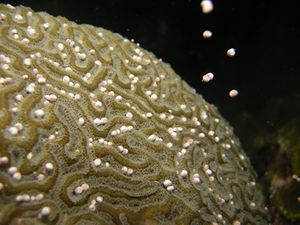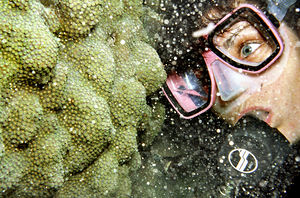TypesofRestoration
Types of Restoration
Physical Restoration
Settlements plates are man-made scientific devices that are designed to simulate the natural strata that corals settle on. Corals settle on the plates during a given time period, and the plates are removed and analyzed in a lab. The amount of coral larvae (coral spat) on each settlement plate allows scientists to learn about the rate of coral recruitment and, therefore, the health of the reef. [1] Scientists often use settlement plates to determine the timing of coral spawning events, which can allow scientists to study the reproductive processes of the reef.
Biological Restoration

Settlement plates measure coral recruitment, which is the process of coral planulae settling on a substrate and commencing to grow their calcium carbonate shell. The health of a coral reef is closely linked to the amount of coral recruitment; the more recruitment, the healthier the reef, and vice-versa. [2] Scientists still do not know very much about the reproductive processes of corals and how a coral planulae ends up where it does. Settlement plates are essential to the study of coral recruitment and the health and growth of a reef.
How are settlement plates used?
Settlement plates are an important scientific tool for assessing the recruitment rates of coral planulae to the reef. They function as a substrate for coral planulae to attach, mimicing ideal conditions. When attaching settlement plates for an experiment, it is extremely important that depth and location on the reef are taken into consideration. In an ideal experiment, the plates are set either at a consistent depth throughout the reef or in one of the 3 main physical structures of the reef: upper fore reef, lower fore reef, back reef (lagoon).[1]
In order to avoid settlement plates causing damage to healthy reefs, they should be firmly attached onto existing dead reef using wire mesh or steel bolts or on heavy, fixed objects like concrete blocks. To attach steel bolts a hole must be drilled through the settlement plate and the substrate, typically an overhang or dead coral head, and secured with either two wing nuts, or the bolt should be screwed in or cemented in. The steel bolts provide a strong, rust-resistant binding that can survive weathering and human or animal interaction.[1]
The best characteristic about settlement plates is that they can be easily removed from coral reefs without causing damage to healthy corals or intruding on the environment. Small unfinished ceramic tiles provide a great mimic to the natural substrate that coral planulae encounter while drifting through in the current. These ceramic tiles have been found to produce equivalent yields to traditionally more damaging, dead coral plates. [2]

References
- ↑ 1.0 1.1 1.2 Harriott, Vicki J., and David A. Fisk. "A comparison of settlement plate types for experiments on the recruitment of scleractinian corals." Marine Ecology Progress Series. 37. (1987): 201-208. Print.
- ↑ 2.0 2.1 2.2 Salinas-de-Leon, Pelayo, et al. "Scleractinian Settlement Patterns to Natural Cleared Reef Substrata and Artificial Settlement Panels on an Indonesian Coral Reef." Estuarine, Coastal and Shelf Science 93.1 (2011): 80-5. GeoRef. Web. 25 Feb. 2013.
- ↑ "Coral Reproduction." NOAA's Coral Reef Conservation Program:. N.p., n.d. Web. 28 Feb. 2013.
- ↑ "Late Summer Full Moons to Cue Spawning on Keys Coral Reefs | NewmanPR." NewmanPR. N.p., n.d. Web. 17 Apr. 2013.